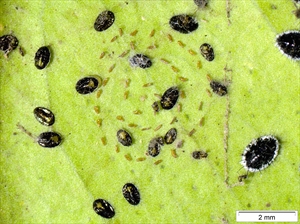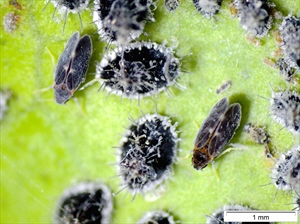Orange spiny whitefly
Pacific Pests, Pathogens, Weeds & Pesticides - Online edition
Pacific Pests, Pathogens, Weeds & Pesticides
Citrus orange spiny whitefly (244)
Aleurocanthus spiniferus
Predominantly tropical Asia (it originated from Southeast Asia), but it has spread to Africa, North America (Hawaii), Europe (restricted), Oceania. It is recorded from Federated States of Micronesia, Northern Mariana Islands, Papua New Guinea, and Solomon Islands.
Citrus species are the main hosts. When the orange spiny whitefly reached Guam in 1951, it was recorded on grape, guava, peach and pear.
Eggs are laid in a spiral on the underside of leaves in batches of about 50 (Photo 1). They hatch in a few days and the 'crawlers' disperse to form new dense colonies on the underside of other leaves (Photo 2). Here they feed on the plant sap. As the larvae moult, legs are lost and they become flattened, oval and brown to black (Photo 1). The pupae are black with a short fringe of cottony wax around the body (Photo 3). The body of the adults and the wings are black (slate blue in some accounts), and they are just over 1 mm long (Photo 4).
It has been recorded as a serious pest of citrus in several countries, and also tea (China) and roses (India). Plants are weakened (i) directly, when large infestations remove sap from the leaves, and (ii) indirectly, when honeydew from the whiteflies falls on the leaves allowing black coatings of fungi to reduce photosynthesis. These fungi are known as sooty moulds.
Look for sooty moulds on the leaves; these are easier to detect as they occur on the top of the leaves. Look, too, for ants that may be attracted to the honeydew of the larvae. Look on the undersides of leaves nearby to find the black, oval, larvae and pupae; the latter is surrounded by white rings of wax. Prominent black spines cover the body. The marginal wax on the pupae is a characteristic used to separate species of Aleurocanthus.
NATURAL ENEMIES
Minute wasps, Encarsia species, parasitise the whiteflies. One species, Encarsia smithi, brought the whitefly under control in Guam after its introduction and, later, was introduced into the Federated States of Micronesia and Hawaii with equally good results. Guam has also received the parasitoid Amitus hesperidum from Mexico. Similar success has been achieved in South Africa with the release of Encarsia smithi against the orange spiny whitefly.
Note that ants may need to be removed if the natural enemies are to be effective in controlling whitefly populations. The presence of parasitoids should be checked. Use a hand lens and look to see if the pupae have holes in them, a sign that parasitoids are present. In this case, avoid the use of insecticides, unless the infestation continues to spread.
CULTURAL CONTROL
- Prune infested stems, branches and fruits and burn them.
- Apply mulch, manure or synthetic fertilizers to assist plant vigour.
- Destroy ant nests with boiling water, without damaging the plants infested with the scale insect; without the ants, parasitoids will bring about natural control of the scale insect.
- For trees, prune low branches and remove weeds to stop ants reaching leaves and fruits.
CHEMICAL CONTROL
In general, chemical control has not been effective against the orange spiny whitefly. However, whiteflies can be controlled using horticultural oil (made from petroleum), white oil (made from vegetable oils), or soap solution (see Fact Sheet no. 56).
- White oil:
- 3 tablespoons (1/3 cup) cooking oil in 4 litres water
- ½ teaspoon pure hand soap, not detergent
- Shake well and use.
- Soap:
- Use soap (pure soap, not detergent):
- 5 tablespoons of soap in 4 litres water.
Commercial horticultural oil can also be used. White oil, soap and horticultural oil sprays work by blocking the breathing holes of insects causing suffocation and death. Spray the undersides of leaves; the oils must contact the insects. A second application of soap or oils may be necessary after 3-4 weeks.
Use synthetic pyrethroid insecticides to kill ants if they are present, attracted to the honeydew. Generally, insecticides are not effective against orange spiny whitefly as they are likely to destroy natural enemies which otherwise will bring about satisfactory control.
AUTHOR Grahame Jackson
Information from Gyeltshen J, et al. (2017) Orange spiny whitefly. University of Florida; FDACS-Division of Plant Industry. (https://edis.ifas.ufl.edu/pdffiles/IN/IN61800.pdf); and Gyeltshen J, Hodges A (2010) Aleurocanthus spiniferus (Quaintance). Featured Creatures. Entomology & Nematology. University of Florida. (http://entnemdept.ufl.edu/creatures/citrus/orange_spiny_whitefly.htm); and from CABI (2020) Aleurocanthus spiniferus (orange spiny whitefly) Crop Protection Compendium. (https://www.cabi.org/cpc/datasheet/4136).
Produced with support from the Australian Centre for International Agricultural Research under project PC/2010/090: Strengthening integrated crop management research in the Pacific Islands in support of sustainable intensification of high-value crop production, implemented by the University of Queensland and the Secretariat of the Pacific Community.







